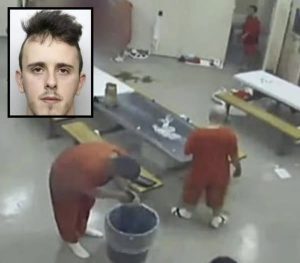Liam Deane’s story is one that sparked a deep sense of sorrow, anger, and disbelief across the country. A man who had been sentenced to life in prison for the brutal murder of his newborn daughter, Luna, was found dead just one month into his sentence. Deane, only 22 years old at the time, had admitted to violently shaking and punching his two-day-old baby because she would not stop crying. The injuries inflicted on little Luna were so severe that she died three days later from devastating brain damage. The case horrified the public, with many struggling to comprehend how a father could harm his own child in such a brutal and unthinkable way.

During the trial, Deane confessed to the attack, explaining that he lost control after Luna’s crying overwhelmed him. The court heard harrowing details of the injuries she suffered—multiple head traumas, bruising, and internal bleeding—all of which pointed to a violent and sustained assault. Medical professionals who examined Luna were shocked by the extent of the damage, describing it as consistent with extreme and repeated force. In his sentencing, the judge emphasized the gravity of Deane’s actions, calling it a tragic and senseless loss of a completely defenseless life. As a result, Deane was handed a life sentence, a punishment that many felt still did not fully measure up to the enormity of his crime.
However, the tragic events surrounding this case did not end with Deane’s sentencing. Just a month after beginning his life term at HM Prison Leeds, Deane was discovered dead in his cell. Authorities quickly launched an investigation, and it soon emerged that another inmate, John Westland, was believed to be responsible for Deane’s death. Westland, a fellow prisoner, appeared in court following the discovery of Deane’s body. Although the full circumstances of what happened inside that prison cell remain somewhat unclear, early reports suggested that Deane had been targeted because of the nature of his crime—a fate not uncommon among inmates convicted of offenses against children.
News of Deane’s death spread quickly, igniting a fierce and emotional response online. Social media platforms were flooded with reactions ranging from satisfaction to outrage. Some expressed that Deane had gotten exactly what he deserved, believing that justice had found a way to serve itself when the legal system, in their view, had fallen short. Others were less willing to celebrate his death, instead criticizing the court system for what they perceived as leniency in Deane’s original sentencing. Many argued that someone capable of such a horrific act against a defenseless infant should never have been given the opportunity to face prison life but should have received a more definitive punishment. The fact that Deane’s life ended violently only seemed to add another layer of tragedy to an already devastating story.
The murder of Luna Deane struck a particularly sensitive nerve in the public conscience. Cases involving the abuse and death of children often provoke strong emotions, but this one seemed to resonate even more deeply. People found themselves grappling with difficult questions about anger, justice, and retribution. How could someone entrusted with the care of a tiny, vulnerable human being turn on them with such brutality? How could a father, who should have been the one to protect and nurture, instead become the instrument of his own child’s destruction? The profound sense of betrayal at the heart of the case amplified the public’s outrage and sorrow.
In the wake of Luna’s death, there were widespread calls for stricter measures to protect infants and young children from harm. Advocacy groups renewed their efforts to raise awareness about the signs of child abuse and the importance of early intervention. Some pointed out that the stress and isolation often experienced by new parents, especially young or inexperienced ones, can sometimes lead to tragic outcomes if support systems are not in place. They emphasized the need for broader societal support to help struggling parents cope before frustration escalates to violence. Yet, even as these important discussions unfolded, the visceral horror of what had happened to Luna remained at the forefront of the public’s mind.
The death of Liam Deane in prison complicated the public’s response to the tragedy. While many found a grim sense of closure in knowing he would no longer live, others reflected on the fact that another act of violence had simply added to the suffering. Violence begetting more violence left a bitter taste for some, who wondered whether true justice had been served or whether the entire situation was a sign of deeper societal failures. Whatever people’s opinions on Deane’s fate, few could deny that the real victim in all of this was Luna—a tiny, innocent baby who never had a chance to experience the world.
Even after the media attention faded, the memory of Luna Deane lingered in the minds of many. Her short life became a symbol of the need for vigilance, compassion, and accountability when it comes to protecting the most vulnerable among us. It also served as a sobering reminder that anger and frustration, left unchecked, can lead to unimaginable tragedy. People across the country mourned for Luna, even though they had never known her, and her story inspired countless conversations about how to prevent such senseless acts in the future.
As for John Westland, the prisoner accused of killing Liam Deane, he eventually faced legal consequences of his own. The court proceedings against him reopened painful wounds for those who had followed Luna’s case closely. Some viewed Westland’s actions as an act of prison justice, while others saw them as a further breakdown of law and order. The complexities of right and wrong, justice and revenge, were brought into sharp focus by the chain of events that unfolded inside those prison walls.
Ultimately, the tragedy of Liam and Luna Deane’s story is one of profound loss—loss of life, loss of innocence, and loss of trust. It is a chilling example of how quickly circumstances can spiral into irreversible devastation when violence enters the picture. It also serves as a painful illustration of how, even when legal systems try to administer justice, the raw emotions of grief, anger, and outrage can create outcomes far beyond the courtroom’s reach. Luna’s memory remains a quiet yet powerful call for a better, kinder, and more vigilant society, one that refuses to turn away from the hard truths exposed by her brief, heartbreaking life.





